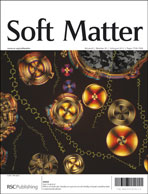Quantitative mesoscale modeling of the oscillatory and transient shear rheology and the extensional rheology of pressure sensitive adhesives
Abstract
The development of novel pressure sensitive adhesives, formed by the drying of a polymer latex emulsion, is hampered by a lack of understanding of the relation between microscopic details and the large-scale rheology. In a previous paper [Soft Matter, 2011, 7, 5036] we introduced a coarse-grained computer simulation model that aims to provide such a link. To reach sufficiently large time and length scales each latex particle is represented by just six degrees of freedom, and transient forces are introduced to capture the effect of slow changes in the degree of chain intermixing and in the number of sticker groups shared between pairs of latex particles. In this paper we show that this model can nearly quantitatively predict the shear and extensional nonlinear rheology by careful tuning of only a few parameters to the linear rheology. We find a complex transient viscosity with multiple inflection points and maxima under shear flow, as well as a strong strain hardening under extensional flow, all in agreement with experimental observations. We investigate the influence of each of the model's parameters on the linear and nonlinear rheology.


 Please wait while we load your content...
Please wait while we load your content...